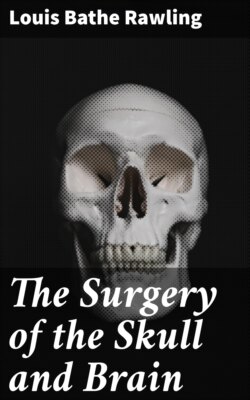Читать книгу The Surgery of the Skull and Brain - Louis Bathe Rawling - Страница 62
На сайте Литреса книга снята с продажи.
(b) Fissured fractures.
ОглавлениеFissured fractures are especially prone to involve the parietal bone, and, in their direction, to follow the lines of ossification. Thus, in the case of the parietal bone, the fissures will radiate from the parietal prominence. There is also a certain tendency for the fracture to remain limited to the particular bone affected.
The presence and extent of the fracture is commonly obscured by the overlying hæmatoma, which is either subpericranial or subaponeurotic. On the other hand, the hæmatoma may, from its size and shape, supply evidence as to the nature of the underlying lesion. Thus, when confined to the parietal bone, it may be inferred that the fracture is also limited to that region. Again, when linear, the presumption is that the fracture is of a similar nature. A definite diagnosis may be impossible without aspiration or till after absorption of the hæmatoma. The fissure will then be found to vary in extent from a mere crack in the bone to a wide gap as broad or broader than the width of the finger. In a case recently under my care the fissure, over half an inch in breadth, extended from the vertex to the base, whilst throughout the whole extent of the gap pulsation was readily obtained.
Fissured fractures in the very young possess another point of interest in that the cleft often tends to increase, this being notably the case when the fracture is associated with injury to underlying dura and brain. The local and general increase of intracranial pressure not only widens the gap, but also leads to thinning and eversion of the margins of the deficiency with possible herniation of brain-matter—traumatic cephalocele.
